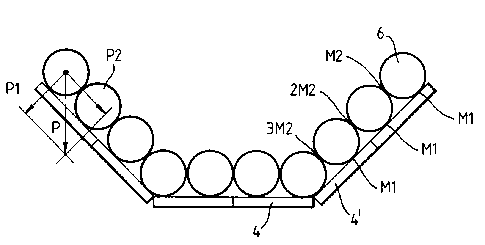Some of the information on this Web page has been provided by external sources. The Government of Canada is not responsible for the accuracy, reliability or currency of the information supplied by external sources. Users wishing to rely upon this information should consult directly with the source of the information. Content provided by external sources is not subject to official languages, privacy and accessibility requirements.
Any discrepancies in the text and image of the Claims and Abstract are due to differing posting times. Text of the Claims and Abstract are posted:
| (12) Patent: | (11) CA 2018414 |
|---|---|
| (54) English Title: | METHOD AND MEANS OF CONVEYANCE OF SOLID MATTER IN PIECES OR PARTICLES |
| (54) French Title: | METHODE ET MOYEN DE TRANSPORT DE MATIERE SOLIDE EN MORCEAUX OU EN PARTICULES |
| Status: | Term Expired - Post Grant Beyond Limit |
| (51) International Patent Classification (IPC): |
|
|---|---|
| (72) Inventors : |
|
| (73) Owners : |
|
| (71) Applicants : |
|
| (74) Agent: | OSLER, HOSKIN & HARCOURT LLP |
| (74) Associate agent: | |
| (45) Issued: | 2001-08-07 |
| (22) Filed Date: | 1990-06-06 |
| (41) Open to Public Inspection: | 1991-01-03 |
| Examination requested: | 1997-05-14 |
| Availability of licence: | N/A |
| Dedicated to the Public: | N/A |
| (25) Language of filing: | English |
| Patent Cooperation Treaty (PCT): | No |
|---|
| (30) Application Priority Data: | ||||||||||||
|---|---|---|---|---|---|---|---|---|---|---|---|---|
|
Method and means of conveyance for solid
material, f.ex. tree trunks (6) or bark, whereby
the solid material is conveyed with parallel,
oblong transfer elements (4) moving back and forth
in transfer direction. A larger part of the
surf ace of the transfer elements (4) is moving
forward at a time than moving backward. The speed
of the return motion of the transfer elements is
higher than that of the feed motion of the trans-
fer elements. Transfer elements (4) at sides of
the conveyor have been inclined on their longi-
tudinal axis so that they slope towards the centre
of the conveyor. In this way the friction force
between the particles (6) of the material to be
conveyed is increased and the friction force
between the maternal (6) to be conveyed and the
transfer elements (4) is decreased.
Note: Claims are shown in the official language in which they were submitted.
Note: Descriptions are shown in the official language in which they were submitted.

2024-08-01:As part of the Next Generation Patents (NGP) transition, the Canadian Patents Database (CPD) now contains a more detailed Event History, which replicates the Event Log of our new back-office solution.
Please note that "Inactive:" events refers to events no longer in use in our new back-office solution.
For a clearer understanding of the status of the application/patent presented on this page, the site Disclaimer , as well as the definitions for Patent , Event History , Maintenance Fee and Payment History should be consulted.
| Description | Date |
|---|---|
| Inactive: Agents merged | 2013-10-23 |
| Inactive: Expired (new Act pat) | 2010-06-06 |
| Inactive: IPC from MCD | 2006-03-11 |
| Inactive: IPC from MCD | 2006-03-11 |
| Inactive: IPC from MCD | 2006-03-11 |
| Grant by Issuance | 2001-08-07 |
| Inactive: Cover page published | 2001-08-06 |
| Inactive: Final fee received | 2001-04-11 |
| Pre-grant | 2001-04-11 |
| Letter Sent | 2000-10-17 |
| Notice of Allowance is Issued | 2000-10-17 |
| Notice of Allowance is Issued | 2000-10-17 |
| Inactive: Approved for allowance (AFA) | 2000-09-22 |
| Amendment Received - Voluntary Amendment | 1998-02-02 |
| Letter Sent | 1997-06-20 |
| Inactive: Application prosecuted on TS as of Log entry date | 1997-06-18 |
| Inactive: Status info is complete as of Log entry date | 1997-06-18 |
| All Requirements for Examination Determined Compliant | 1997-05-14 |
| Request for Examination Requirements Determined Compliant | 1997-05-14 |
| Application Published (Open to Public Inspection) | 1991-01-03 |
There is no abandonment history.
The last payment was received on 2001-05-23
Note : If the full payment has not been received on or before the date indicated, a further fee may be required which may be one of the following
Please refer to the CIPO Patent Fees web page to see all current fee amounts.
| Fee Type | Anniversary Year | Due Date | Paid Date |
|---|---|---|---|
| Request for examination - standard | 1997-05-14 | ||
| MF (application, 8th anniv.) - standard | 08 | 1998-06-08 | 1998-05-19 |
| MF (application, 9th anniv.) - standard | 09 | 1999-06-07 | 1999-05-28 |
| MF (application, 10th anniv.) - standard | 10 | 2000-06-06 | 2000-05-11 |
| Final fee - standard | 2001-04-11 | ||
| MF (application, 11th anniv.) - standard | 11 | 2001-06-06 | 2001-05-23 |
| MF (patent, 12th anniv.) - standard | 2002-06-06 | 2002-05-17 | |
| MF (patent, 13th anniv.) - standard | 2003-06-06 | 2003-05-20 | |
| MF (patent, 14th anniv.) - standard | 2004-06-07 | 2004-05-17 | |
| MF (patent, 15th anniv.) - standard | 2005-06-06 | 2005-05-27 | |
| MF (patent, 16th anniv.) - standard | 2006-06-06 | 2006-05-24 | |
| MF (patent, 17th anniv.) - standard | 2007-06-06 | 2007-05-28 | |
| MF (patent, 18th anniv.) - standard | 2008-06-06 | 2008-05-23 | |
| MF (patent, 19th anniv.) - standard | 2009-06-08 | 2009-05-22 |
Note: Records showing the ownership history in alphabetical order.
| Current Owners on Record |
|---|
| RAUMA-REPOLA OY |
| Past Owners on Record |
|---|
| ARVO JONKKA |